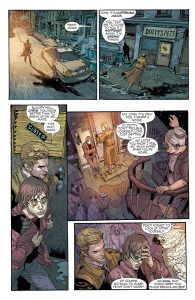
Hard to believe DC cancelled Hellblazer in favor of this. That is, until you remember this is DC we’re talking about. Hellblazer‘s version of Constantine–a drinking, smoking bloke first, a con man second, and sorcerer a distant third–had legs, strengthened by the likes of Garth Ennis, Paul Jenkins, Brian Azzarello, and Peter Milligan, amongst others. While that series mingled magic, crime, and identity politics (a British/Scottish set of themes), the new and 52-ed Constantine removes such concerns in favor of generic adventure. After all, why have a unique voice, angle, and presentation when you can build a plot straight out of a Stephen Sommers movie?
 This studio thinking is reflected in Jeff Lemire and Ray Fawkes’ script. All the impersonal touch of an office block middle manager, none of the attention to detail. They transfer their two-dimensional version of Constantine from Justice League Dark (he’s British; he’s a jerk) into a solo series, and despite all his talk about magic coming with a price, there’s still a witless air about him. At one point, he employs an easy to suss trick (which doesn’t even improve his circumstances) while sacrificing someone else. Naturally, Lemire and Fawkes relegate their ethical considerations of this act to a spineless “I’m sorry” and a mournfully long shadow. It’s an imitation of the standard Lee/Ditko ending, where Peter Parker walks away sulking about how he gets blamed for everything or screwed up a relationship. One could easily see Ennis or Jenkins using it as a form of satire or deconstruction of morose superhero comics (the distended version of “Parker Luck” storytelling). Lemire and Fawkes have no such consideration, they’re just here to pump out more material.
This studio thinking is reflected in Jeff Lemire and Ray Fawkes’ script. All the impersonal touch of an office block middle manager, none of the attention to detail. They transfer their two-dimensional version of Constantine from Justice League Dark (he’s British; he’s a jerk) into a solo series, and despite all his talk about magic coming with a price, there’s still a witless air about him. At one point, he employs an easy to suss trick (which doesn’t even improve his circumstances) while sacrificing someone else. Naturally, Lemire and Fawkes relegate their ethical considerations of this act to a spineless “I’m sorry” and a mournfully long shadow. It’s an imitation of the standard Lee/Ditko ending, where Peter Parker walks away sulking about how he gets blamed for everything or screwed up a relationship. One could easily see Ennis or Jenkins using it as a form of satire or deconstruction of morose superhero comics (the distended version of “Parker Luck” storytelling). Lemire and Fawkes have no such consideration, they’re just here to pump out more material.
Renato Guedes’ imagery is competent as far as taking readers from Point A to Point B. Layouts are straightforward top-to-bottom, left-to-right, affairs. His rare departure is a splash page collage, depicting a sorcerer blowing a man up with magic. It’s out-of-place not just stylistically (closer to Rafa Sandoval’s Catwoman, which emphasizes eerie, psychological menace), but thematically as well. The actual explosion, and the resulting gore, is depicted as a money shot, the triumphant image of the sorcerer looking straight down her low-cut top as she gets covered in blood. This isn’t bad because it’s in poor taste, only because it’s a clumsy use of horror tropes in an adolescent script.
Guedes’ overall competence does underscore how poorly-thought the writing is, though. Two scenes in particular are exposed: an early scene where a man “sneaks up” on Constantine by simply standing in front of his home (with nothing around to hide behind, Guedes just puts a convenient shadow over his face), and another where Constantine notices someone has poisoned his drink. The latter is Lemire/Fawkes trying to show his eye for detail, except Guedes has the assassin offering the drink while poisoning it…right next to Constantine’s face (instead of, I don’t know, before giving it to him?). For a comic so haphazard in design, the art suits it.














Your positives and negatives section listed above the article made me laugh. I felt bad for putting this one back on the shelves (the first New 52 comic I haven't tried), but it looks like I just saved myself 2.99 on Wednesday. Maybe it'll get better…?
I'm a devotee to Milligan's interpretation of Constantine. I like Lemire, but he's in over his head. JLD told me as much. Frankly, you need someone that no British culture to nail Constantine because, like you said, he's a drinking, smoking bloke first, a con man second, and sorcerer a distant third–had legs.